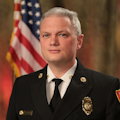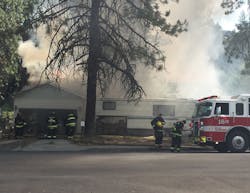The term wildland/urban interface (WUI) has been used for more than 20 years to identify an area where residential homes are built in a known wildland area (Gorte, 2008). The definition listed in the 2001 Federal Register notice more correctly identifies WUI as a community that exists where humans and their development meet or intermix with wildland fuel. Section 301 of the 2015 Wildland-Urban Interface Code adds enabling legislation for jurisdictions. The section assists fire agencies in establishing some baseline criteria for the designation of WUI areas and a methodology. But while regulations and standards concerning WUI can be found throughout fire service and public safety doctrine, the overwhelming nature of WUI risk to the U.S. fire service continues to be an afterthought for many—until a catastrophic event occurs.
Real risks
The 10 most fire-prone states are located in the West and have received far more than their share of population growth. In fact, nearly half of the population growth in the United States has occurred in the West; however, WUI fire hazards are not confined to this region (Kennedy & Troy, 2007). WUI fires routinely occur in the Southwest, Midwest and other isolated states, such as Alaska and Hawaii.
Overall wildland fire activity has amplified considerably over the past 30 years as average temperatures and extreme droughts have steadily increased. Science supports firefighters’ continued belief that our wildland fire seasons continue to get longer in duration—in fact, about two and a half months longer than was the average 25 years ago.
In the recent times, we have experienced droughts that have increased in duration, severity and frequency as a result of increased temperature (Groisman & Knight, 2008). The foundation of these trends can be attributed to four primary classifications—and all relate to human activity:
- Our state and national fire-suppression philosophy and accompanying policy, contributing to increasing fuel loads in forests and the WUI;
- Biases in the insurance discipline, leading to the underrepresenting risk for property located in the WUI;
- Global climate change, leading to longer, hotter and drier fire seasons; and
- Government decisions to allow development to occur unimpeded in some of the most hazardous WUI situations.
The science is truly irrefutable, although some continue to try to contest it, and the risk to firefighters working in this theater is nothing less than extraordinary.
Reviewing 2015
In my region, the Pacific Northwest, we are particularly susceptible to massive wildland fires, and nearly every project fire involves some level of urban-interface. (Note: A project fire is a fire of such size or complexity that a large organization and prolonged activity is required to suppress it.) We are not unlike any of our other nearby states, and the culture of our region has embraced an increasing desire over the past 50 years to locate permanent and seasonal homes in the wilderness.
In a letter sent on June 30, 2016, from Pacific Northwest Coordinating Group Chair Brian Tonhika to all of the fire service leadership, he reflected on last year’s challenge in preparation for 2016:
Following an active fire season in 2014, the 2015 fire season was one of incredible success as well as tragedy. The 2015 fire season saw the NW Geographic Area at Preparedness Levels (PL) 4 and 5 for the longest number of days (24 days at PL 4, and 23 days at PL 5, for a total of 47 days) in nearly 10 years. In response to these heightened PLs, the Northwest MAC was activated for 41 days. During that time, large fires were spread from Southwest Oregon to Northeast Washington, touching virtually every sub-geo area within the Geographic Area. Six of those fires approached or exceeded 100,000 acres each. As many as 11,450 personnel (at a given time) were deployed during the peak of fire activity. Despite the high loss of acres, by far the largest loss was that of 3 firefighters near Twisp, WA. No amount of resources is worth the cost of a firefighter’s life. This loss is a sobering reminder of the risks you take when responding to wildfire. PNWCG's goal is and continues to be, zero firefighter deaths. This takes all of us, whether we are firefighters on the ground, serving as Agency Administrators or members of PNWCG. Each of us plays a part in ensuring our resources are safe and prepared to respond.
During our 2015 fire season, we welcomed agencies and personnel from every region in the United States, as well as participation from Canada and Australia. Aside from very few and isolated logistical issues, our ability to move the massive amount of resources across state, regional and international borders was flawless and nothing less than exceptional.
Even more interesting was the adaptation of an incredibly diverse group of civilian, municipal, seasonal and military personnel into a national training and operationally preparedness framework that is well known to many as the National Wildland Coordinating Group (NWCG). Firefighters of all types were being trained or re-trained in operating within the wildland theater, and the structural fire resources in particular spent hours becoming reacquainted with structural protection tactics and wildland firefighting safety. Being prepared, or “operationally ready,” is our collective responsibility, regardless of the risk or geography, and being situationally aware should be a priority for all us.
Preparing for future events
Maintaining a national understanding of the level of wildland risk and situational awareness is easier now with modern technology. Agency leaders, company officers and firefighters all have the ability to read the most recent intelligence on active incidents, learn about the level of risk, and make preliminary preparations for protecting their community, neighboring community or a community in need anywhere in the United States.
With that in mind, following is a list of important websites that provide leaders with a larger perspective of the nation’s fire situation:
- National 7-Day Significant Potential: psgeodata.fs.fed.us/forecast
- National Situation Report: www.nifc.gov/nicc/sitreprt.pdf
- National Interagency Coordination Center Predictive Services: predictiveservices.nifc.gov
Before the fire season, fire chiefs and agency administers should also establish and maintain robust relationships with their federal partners, including the National Weather Service, Federal Forest Service and State Department of Natural Resources/Lands. Most federal and state organizations have access to NWCG training material, credentialing agreements and processes, as well as access to the Resource Ordering and Status System (ROSS). Chiefs and policymakers have the ability to enter into legal agreements with federal and state agencies that allow for entry of a municipal fire department or fire district into the federal wildland system. After all, post-9/11, we are all supposed to be speaking the same language, and that means much more than just pushing a button to talk.
Response plans and deployment
An agency’s wildland response plans should reflect the level of risk predicted from corroborated intelligence. Several organizations that are well versed in wildland response are intimately familiar with factors such as weather predictions, historical patterns and fuel modeling. In contrast, agencies that do not respond to wildland incidents on a frequent basis may not consider those factors. The key: The initial selection and number of resources sent on a possible WUI incident may truly dictate (or significantly contribute to) the outcome.
Many agencies use a matrix that is developed based on risk and that relies on local or regional risk ratings. The ratings then apply to the resources. See the charts for an example for a single wildland fire without the added complexity of a significant WUI risk. Compare that to the WUI risk chart, which may look far different for some agencies.
Response plans will vary considerably between organizations depending on factors like risk, availability of resources, and tactics. When developing response plans for the WUI, organizations should follow a process similar to a standard of coverage critical task analysis. A WUI incident can be extremely complex due to varying incident objectives, fuels, fire behavior, weather and many other factors. Unlike the traditional task analysis that we would use for a structure fire, a much larger picture of the potential should be brought into the equation as well as the amount of time necessary for some of the resources to respond.
For the most part, buildings are static, and it is relatively simple to stop the transmission of fire from the fire building to exposure. In contrast, a WUI fire may communicate via brands and wind changes blocks or even miles away from the origin, making the incident commander’s theater of operation much larger than what many are used to. Furthermore, for some of the larger aircraft and dozer programs, it may take up to an hour to mobilize and engage in an incident. Compared to what we are used to in the structural world, the concept of response time and the period until engagement may be much different. The adage of call early and be proactive cannot be understated when it comes to WUI incidents.
Engage—now
WUI incidents and our nation’s response to wildland fire, in general, will continue to be on the policy and political forefront for many years to come. The fire service has an opportunity to collaborate and engage with the federal system to improve our collective response, or we can remain in our silos and be in the audience while fire threatens areas surrounding us. For those in the latter group, the fires will eventually burn into your jurisdiction or have an economic impact on your community. Now is the time to engage.
References
- Gorte, R. W. (2008). Wildfire protection in the wildland-urban interface: Washington, D.C.: Congressional Research Service, the Library of Congress.
- Groisman, P., & Knight, R. (2008). “Prolonged Dry Episodes over the Conterminous United States: New Tendencies Emerging during the Last 40 Years.” Journal of Climate, 21(9), 1850–1862.
- Kennedy, R. G., & Troy, A. (2007). “Living on the Edge: Economic, Institutional and Management Perspectives on Wildfire Hazard in the Urban Interface.” Oxford: Emerald Group Publishing Limited.
About the Author

Brian Schaeffer
Brian Schaeffer is the fire chief for the Spokane, WA, Fire Department. His professional life spans more than 30 years in fire departments in the Midwest and Pacific Northwest. Schaeffer serves on numerous local, state, and national public safety and health-related committees. He frequently lectures on issues that involve innovation, leadership and public safety technology. Schaeffer is a member of the Firehouse Editorial Advisory Board.
